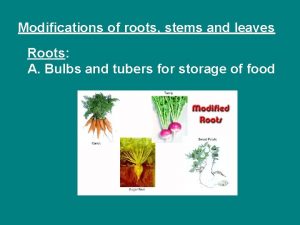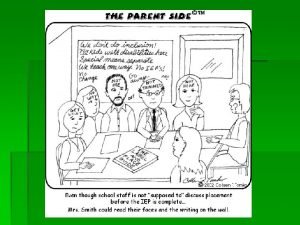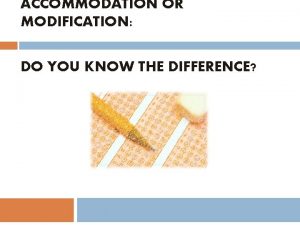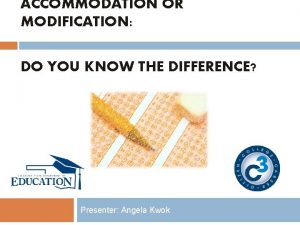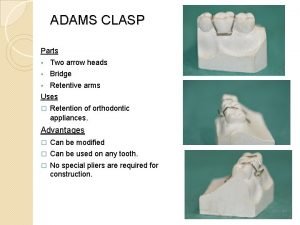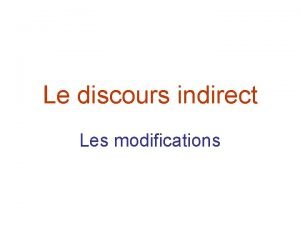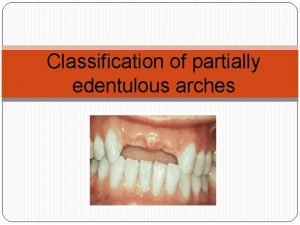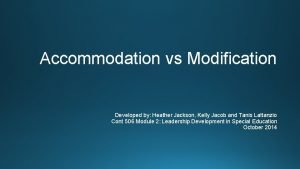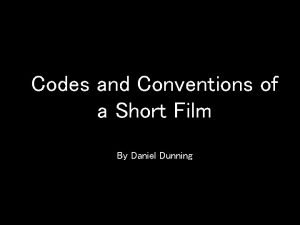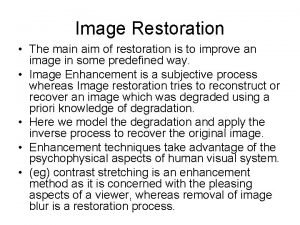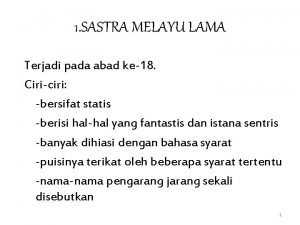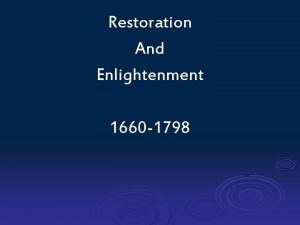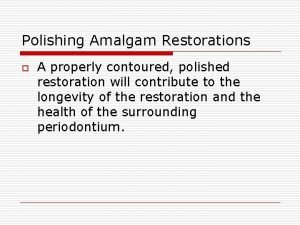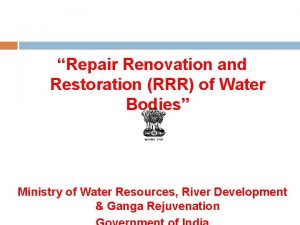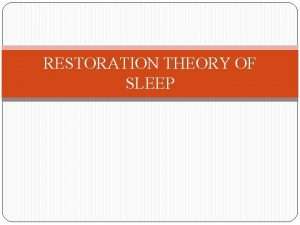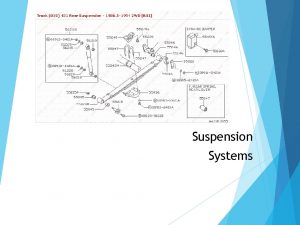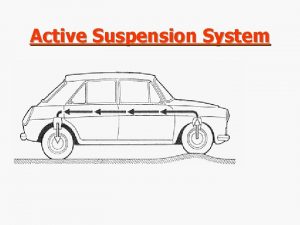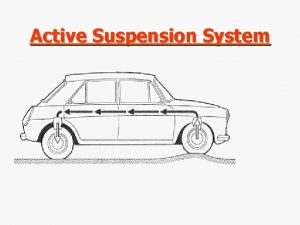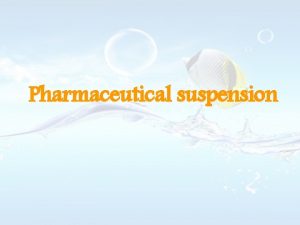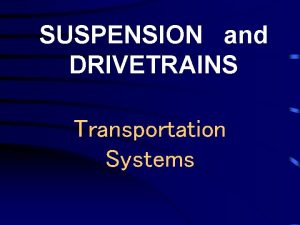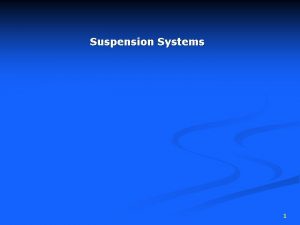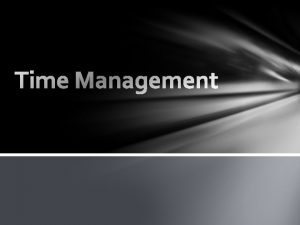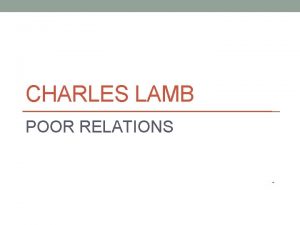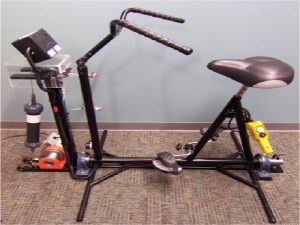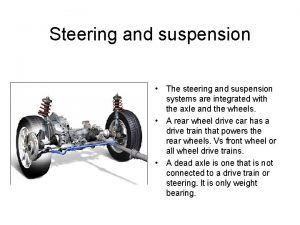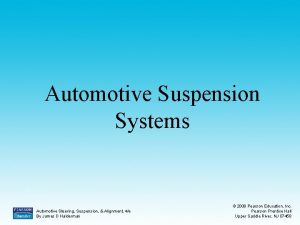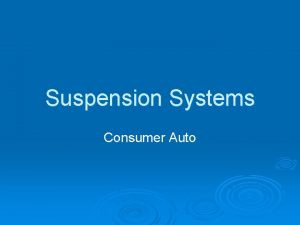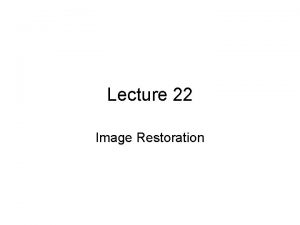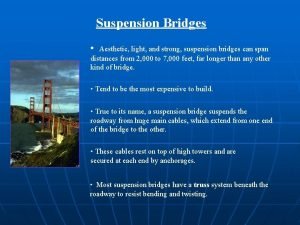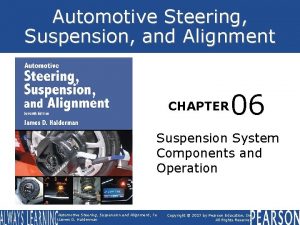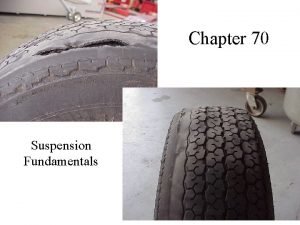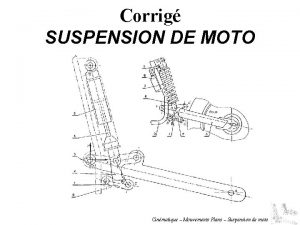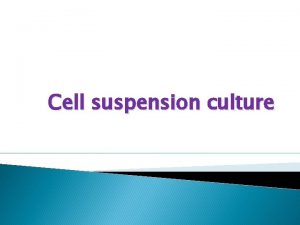Suspension Systems Restoration And Modifications Typical Symptoms Poor
































- Slides: 32

Suspension Systems Restoration And Modifications

Typical Symptoms • • Poor handling Poor steering Poor Braking Excessive sway Excessive bump steer Excessive tire wear Bump and Knock noises

Restoration and Repair Parts. • • • Shocks Struts Ball joints Tie Rods Bushings Alignment

Alignment Aids • Cam Bolts • Adjustable Ball Joints

Part Numbers • MOOG Part # K 5292 Front Suspension; Upper; Problem Solver; adjustable ball joint; adjustment range from -1 to +1 Deg. • SPICER Part # 6161014 Cam Bolt, Rear Suspension; Up To Plus / Minus 3 Degrees Camber; Single Offset

Special Tools • • Ball Joint Separator Tie Rod Separator Spring Compressor Safety Chain

Bump Steer Issue • Only 1984 thru 1987 have the issue. • Bump steer is the toe-in or toe-out of the rear wheels as the suspension goes from normal ride height through full bump (suspension system moves up) to full droop (suspension system moves down). • Bump steer affects handling much as setting toe-in does. • Worn suspension components can make it worse. • Excessive bump steer increases tire wear and makes the vehicle more difficult to handle on rough or uneven roads.

Alignment The Pontiac Fiero is designed with independent rear suspension that is service adjustable, making four-wheel alignment possible. This is different from all other Pontiac models, both FWD and RWD, which have solid rear axles with fixed alignment. • Fiero’s should have a 4 -wheel alignment. • MVMA Specifications are the specs that are pre-programmed on many alignment machines. • Do it Yourself Alignment. • http: //bhughes. lonestarfieros. org/Fiero_Alignment/Home_Alignment. htm

Alignment Specifications • • Factory specified alignment settings for 84 -87 models (from the 1987 MVMA Specifications) Front camber +0. 5 degrees Front caster +5. 0 degrees Front toe +0. 15 degrees (this is approximately equivalent to 1/16 inch toe-in) Rear camber -1. 0 degrees Rear toe +0. 15 degrees (this is approximately equivalent to 1/16 inch toe-in) • Factory specified alignment settings for 88 model (from the 1988 MVMA Specifications) Front camber +0. 0 degrees Front caster +3. 0 degrees Front toe +0. 15 degrees (this is approximately equivalent to 1/16 inch toe-in) Rear camber -1. 0 degrees Rear toe +0. 15 degrees (this is approximately equivalent to 1/16 inch toe-in) • • •

Technical Service Changes • 1984 -1987 rear spec change TSB # 87 -3 -10 • Changes the rear toe from. 15 degrees to 0 degrees. • • 1988 revised alignment specs TSB # 88 -3 -11 Changes Front Caster from 3. 0 to 5. 0 degrees for GT and Formula. Front toe from. 15 to. 3 degrees and Rear toe to. 5 degrees. Adds front and rear cross car camber to be within. 75 degrees, Front cross caster must be within. 75 degrees. • Tie rod boot must not be twisted and must be seated in the tie rod groove. • Vehicle must be jounced three times before checking alignment to eliminate false geometry readings.

Adjustment Points • 1984 -1987 Fiero’s

Adjustment Points • 1988 Fiero’s

Cam Bolts • All Years ~ Rear Camber Adjustment.

Modifications • • Polyurethane Bushings Bump Steer Elimination (84 -87) Lowering Sway Bars Adjustable Shocks and Struts Strut Tower Brace Wider/Bigger Wheels and Tires.

Polyurethane Bushings • • • More precise handling Firmer control and positive steering (reduced effort) Virtually impervious to oil and other road contaminants Will not crush down or wear out like rubber bushings Designed to be free-floating, rotating 360 degrees, so the suspension can articulate fully without binding

Bump Steer Elimination • HT Motorsports sells the kit. • Kit includes: 2 control arms, 2 toe links, 2 knuckle adapter brackets. Control arms come with urethane pivot bushings, sleeves and weather-proof spherical bearings at the knuckle assembly. Installation: Basically Bolt-On There are no frame modifications required. The knuckle assembly requires some minor modifications. (One hacksaw cut 1 1/2" long. ) The steering arm taper is drilled out using the fixture provided.

Lowering • • • Springs Dropped Spindles Adjustable Coil-Over Suspension Kits Cutting Springs

Why Lower Car? • Spring rates on stock Fieros are correct for most purposes, but the problem is that most of these cars are too high off the ground. The least expensive way to lower either the front or the rear is to cut the existing springs. By cutting half a coil off a spring and reforming the ends, you can lower your fiero about one inch. Lowering the car reduces the available ride travel, but for most driving conditions, there is no loss of ride quality. with Koni adjustable shocks and struts, you can tune the ride quality in relation to to improved handling. • Do NOT cut springs while they are mounted on the car or under NOT compression.

Stabilizer and Sway Control • Sway bars • Strut Tower Brace

Steering Stabilization • Neutral Steer: The front and rear of the vehicle will drift an equal amount and you will end up close to the starting point (actually, you will end up a little further out since the front and rear are drifting the same). • Under steer: Front tire drift causes the vehicle to refuse to turn as sharply as the direction of the wheels are pointed. If the wheels and the throttle are held steady, the vehicle will make an ever widening circle. • Over steer: Rear tire drift is greater than that of the front and the rear tends to "spin out". The vehicle will end up closer to the center of the circle because the rear tire drift changes the direction inward. • Tire Drift: The transfer of weight to the outside front wheel with an inadequate front or rear bar distorts the tires so they actually drift sideways during cornering.

Why add or change stabilizer bars? • Adding and/or changing the stabilizer bars are the most significant handling improvements you can make on your Fiero. Due to the Fiero's inherent tendency to spinout at the limits of its cornering power, Pontiac engineers tuned the cars handling characteristics to provide an excessive amount of understeer. This trait ensures safe handling for the majority of drivers, but does not permit fast cornering. The stock Fiero uses a front stabilizer bar and no rear stabilizer bar to create the desired understeer. If your Fiero has polyurethane rear control arm bushings, its rear suspension is capable of absorbing more cornering force, so some amount of rear stabilizer can be used. I have found that by increasing the effectiveness of the front stabilizer bar, we can use a large rear stabilizer bar. By matching the size of the front and rear bars, it is possible to make a Fiero handle with neutral steer instead of excessive understeer. Neutral steer provides the maximum cornering speed because all the tires work at the same level. Large front and rear stabilizer bars limit the body roll angle and positive camber, which keeps the tires from losing cornering power. • The use of large front and rear stabilizer bars doesn't have any significant effect on ride quality or road noise. The addition of the front and rear bars will also make a significant improvement in steering response and precision. A 1. 25 inch diameter bar in the rear should be used in conjunction with a one inch front stabilizer bar. Do not use a rear bar without the front; doing so will result in oversteer, which can be very dangerous. • Using a larger front bar improves the steering precision, allowing removal of the stock steering dampener. The Fiero dampener reduces steering wheel kickback and vibration, but with a more effective front stabilizer bar, these problems are minimized so it is no longer needed. Removing the steering dampener also allows the steering wheel to turn faster for improved handling and overall control.

Tires and Wheels • Making a standard production car handle well on the racetrack often requires a variety of modifications. Each change is aimed at correcting one or more problem areas. You should start from the ground up by selecting the right tire sizes. • The basic handling problems any rear- or mid-engine car is that the center of gravity is behind the traction center of the tires. Rear-engine race cars compensate for this by using larger tires on the back and smaller tires on the front. This moves the traction center to the rear so it is on, or behind, the center of gravity. You can use larger rear tires on your Fiero for the same benefit. The stock rear fenders have room for 255/50 x 16 tires on 16 x 9 wheels, although 225/50 x 16 tires on 16 x 8 wheels will also provide improvement. ~ Herb Adams

Wheel Offsets • Production cars are built with wheel offsets that minimize wheel-bearing load. In corners, excessive lateral tire loads add stress to wheel bearings. • Fiero’s have Positive Offset. The hub mounting surface is toward the front or wheel side of the wheel. Positive offset wheels are generally found on front wheel drive cars and newer rear drive cars. • To convert from inches to mm multiply by 25. 4 • To convert from mm to inches divide by 25. 4

Aftermarket Wheel Offset • As wheel widths change, the offset combined with the new width must be chosen properly so that the wheel and tire have enough space within the wheel well to avoid rubbing or unwanted contact with other components. • Improper wheel offsets can lead to a variety of problems ranging from poor handling characteristics to broken suspension components • Altering wheel offsets also affects the scrub radius. Recall that the scrub radius is the ground-level measurement between the kingpin inclination axis (KIA) and the tire contact patch's center. • If the KIA intercepts the ground outboard of the tire contact patch's center, then the scrub radius is negative. On the other hand, if the KIA intercepts the ground inboard of the tire contact patch's center, then the scrub radius is positive. Fiero’s are usually set up with a negative scrub radius. • A negative scrub radius is preferred for front-wheel-drive cars since it gives a stabilizing effect when traction between the left and right wheels varies. If a single front wheel loses traction during acceleration or braking-like what would occur if one tire goes over a patch of ice-the other front wheel will toe-out a certain degree depending on the amount of steering compliance, which will tend to steer the car in a straight line. At the same time, the driver will feel a certain amount of kickback through the steering wheel. • Offset also affects suspension stiffness through the suspension's motion ratio. With less offset, the wheel's leverage about the inboard lower control arm pivot increases while the suspension spring leverage remains constant. The net effect is a reduction in the effective wheel spring rate.

Measuring Wheel Offset • • To calculate offset you'll need the following measurements: Wheel back space, Wheel Width, and Wheel Center line (outboard flange to inboard flange measurement / 2) • Subtract: Wheel center line from Wheel backspace to get offset. If backspace is less than the wheel centerline the offset is negative If backspace is greater than the wheel centerline the offset is positive • To maintain handling characteristics and avoid undue loads on bushings and ball joints, the car manufacturer's original offset should be maintained when choosing new wheels unless there are overriding clearance issues. • Wheels are usually stamped with their offset using the German prefix "ET", meaning "Einpresstiefe" or, literally, "insertion depth". An example would be "ET 45" for a 45 mm offset. • Calculating the offset of a wheel is a fairly easy mathematical equation. First, measure the overall width of the wheel (remember, just because a wheel is 18 x 7. 5, does not mean that the OVERALL width is 7. 5”. It means that the measurement between the outboard flange and the inboard flange is 7. 5”). Next, divide that width of the wheel by two; this will give you the centerline of the wheel. • • • Overall width/2 = Centerline After determining the centerline, measure from the hub-mounting surface of the hub to the edge of the inboard flange (if the wheel were laying flat on the ground – face up – your measurement would be from the ground to the hub-mounting surface). This is your back spacing. Back spacing - Centerline = Offset in Inches

Fiero Wheel Offsets • 13” X 5. 5 Steel or Turbo Fin have a 42 mm offset. • 14” X 5. 5” Steel Wheels have a 42 mm offset. • 14” X 6” High Tech Aluminum have a 35 mm offset. • 15” X 7” Diamond Spoke for 86 and 87 have a 30 mm offset. • 1988 15” X 6” Diamond Spoke fronts have a 37 mm offset. • 1988 15” X 7” Diamond Spoke rears have a 30 mm offset.

Aftermarket Wheel Guide

Plus Size Tire Sizing • The Plus concept was developed by performance-minded car owners and tuners who wanted to be able to put wider, bigger wheels and tires on their cars without sacrificing speedometer accuracy. • The Problem Your car's speedometer is calibrated by telling the needle you see on the dashboard how many times the wheel spins around. The problem is, if you make your wheel diameter smaller, it's going to spin more times to go the same number of miles. Your car doesn't know you changed your tire and wheel size, so it will give you an inaccurate reading. • The Solution In order to keep your speedometer accuracy, you need to change your tires and wheels in such a way that the overall diameter of the setup does not change significantly. For instance, a 225/60 -16 has the same rolling diameter as a 245/50 -17. The larger tire will give better traction and cornering because it is wider and has a lower aspect ratio, but won't throw off the speedo. • The Plus One The Plus concept takes it a step further, and formulates the tire size you'll need if you increase your wheel diameter by an inch, for instance changing from a 15 -inch to a 16 -inch wheel and tire. As the wheel diameter goes up, the aspect ratio goes down to compensate for the changes. There also formulas for Plus Two, Plus Three and so on depending on how big you want to go. You can even do a Plus Two or Plus Three, as long as you keep the dimensions under control.

Tire Sizes • Example tire size 205/65 R 15 • • RIM HEIGHT (15") The diameter of the rim, which is also the diameter of the hole opening of the tire. You MUST match tire inter hole diameter to rim height. Which means you cannot put a 16" tire on a 17" rim. • • RIM WIDTH (7") The width between the flanges of the wheel. (the part the bead of the tire touches). • • SECTION WIDTH (205 millimeters) The linear distance between the outside of the sidewalls of an inflated tire without any load on it (this does not include any sidewall raised lettering). • • SECTION HEIGHT (65% of Section Width) This is also known as the Aspect Ratio. This is figured on a percentage of the section width. A tire size of 205/65 R 15 would have a section width of 205 millimeters and a section height of 65 percent of 205 millimeters or 133. 25 mm. • R: The "R" means Radial.

DETERMINING TIRE HEIGHT • • • Tire Height = Rim Height + 2 (Section Height). You will notice that tire sizes are measured in TWO units, millimeters and inches. To keep things simple, it is best to convert to ONE unit. I will use inches. To convert millimeters to inches divide by 25. 4 (Example: 205 mm/25. 4=8. 07" or 8"). So, the stock tire is 8. 07" wide. To determine the section height, take the Aspect Ratio times the tire width. On the stock tire, the Aspect Ratio is 65 or 65 percent of the width. Therefore, the section height on the stock tire is 8. 07" X. 65 = 5. 2455" or rounded off, 5. 25 inches. Remember, there are two section heights when determining the overall height of the tire. The rim size is 15 inches. Plugging these figures into the tire size formula, we have: • Stock Tire height = 15" + 2 (5. 25") which equals 25. 5 inches.

How Big Can You Go? • Examples of Tire Plus Sizes that can be upgraded. Tire Size Width Height 205 65 15 8. 07 25. 49 225 60 15 8. 86 25. 63 225 55 16 8. 86 25. 74 245 50 16 9. 65 25. 65 245 45 17 9. 65 25. 68 255 40 17 10. 04 25. 72 275 40 17 10. 83 25. 66 275 35 18 10. 83 25. 58

Questions and Comments
 Symptoms of poor delegation
Symptoms of poor delegation Suspension therapy for shoulder joint
Suspension therapy for shoulder joint How to know if your period is coming or your pregnant
How to know if your period is coming or your pregnant Plant modifications of roots stems and leaves
Plant modifications of roots stems and leaves Accommodations and modifications
Accommodations and modifications Difference in accommodations and modifications
Difference in accommodations and modifications Accommodation vs modification
Accommodation vs modification Blackhawk king air 350
Blackhawk king air 350 Adams clasp with single arrowhead
Adams clasp with single arrowhead Discoirs direct
Discoirs direct Beckett classification of partial denture
Beckett classification of partial denture Accommodation vs modification
Accommodation vs modification Short film conventions
Short film conventions Difference between typical and atypical pneumonia
Difference between typical and atypical pneumonia Decision support systems and intelligent systems
Decision support systems and intelligent systems Restoration drama and prose
Restoration drama and prose Enlighten about image noise and restoration
Enlighten about image noise and restoration Chapter 56 conservation biology and restoration ecology
Chapter 56 conservation biology and restoration ecology Chapter 55 ecosystems and restoration ecology
Chapter 55 ecosystems and restoration ecology Restoration prose
Restoration prose Image sharpening and restoration
Image sharpening and restoration The restoration and 18th century literature
The restoration and 18th century literature The restoration refers to the
The restoration refers to the Repair and restoration theory of sleep
Repair and restoration theory of sleep The restoration and the 18th century notes
The restoration and the 18th century notes Amalgam ditching definition
Amalgam ditching definition Chapter 55 ecosystems and restoration ecology
Chapter 55 ecosystems and restoration ecology Repair renovation and restoration of water bodies
Repair renovation and restoration of water bodies The restoration and the last stuarts
The restoration and the last stuarts Repair theory of sleep
Repair theory of sleep Types of thought process
Types of thought process Why are some countries rich and others poor
Why are some countries rich and others poor Economics for leaders
Economics for leaders



